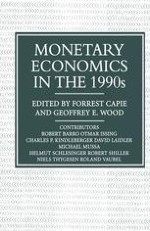1996 | Book
Monetary Economics in the 1990s
The Henry Thornton Lectures, Numbers 9–17
Editors: Forrest Capie, Geoffrey E. Wood
Publisher: Palgrave Macmillan UK
Book Series : Studies in Banking and International Finance
Included in: Professional Book Archive
